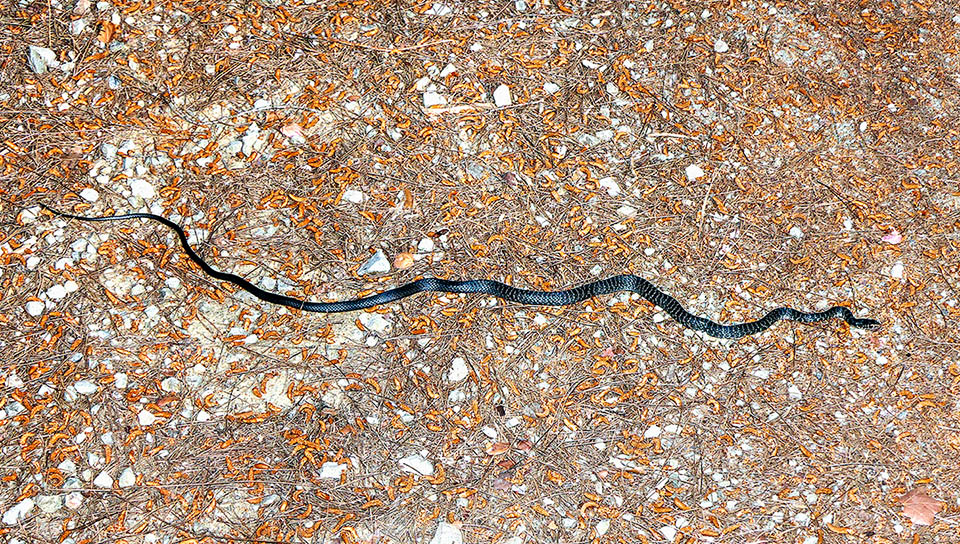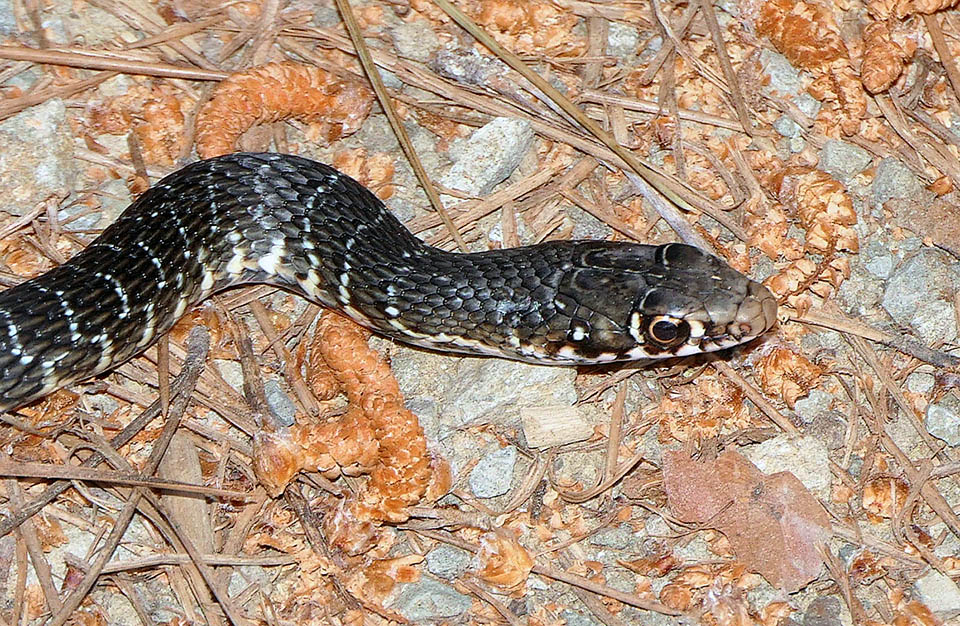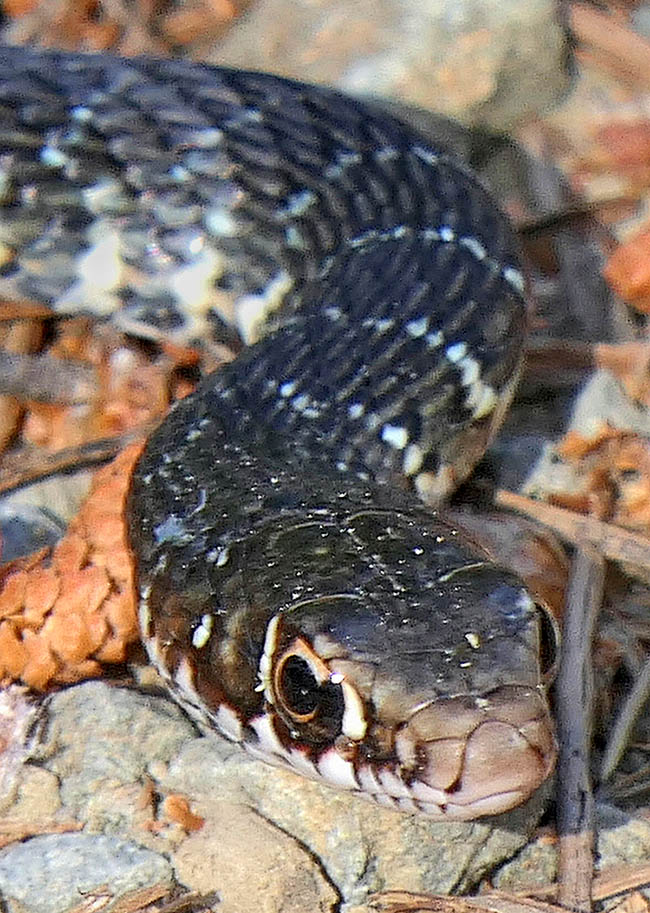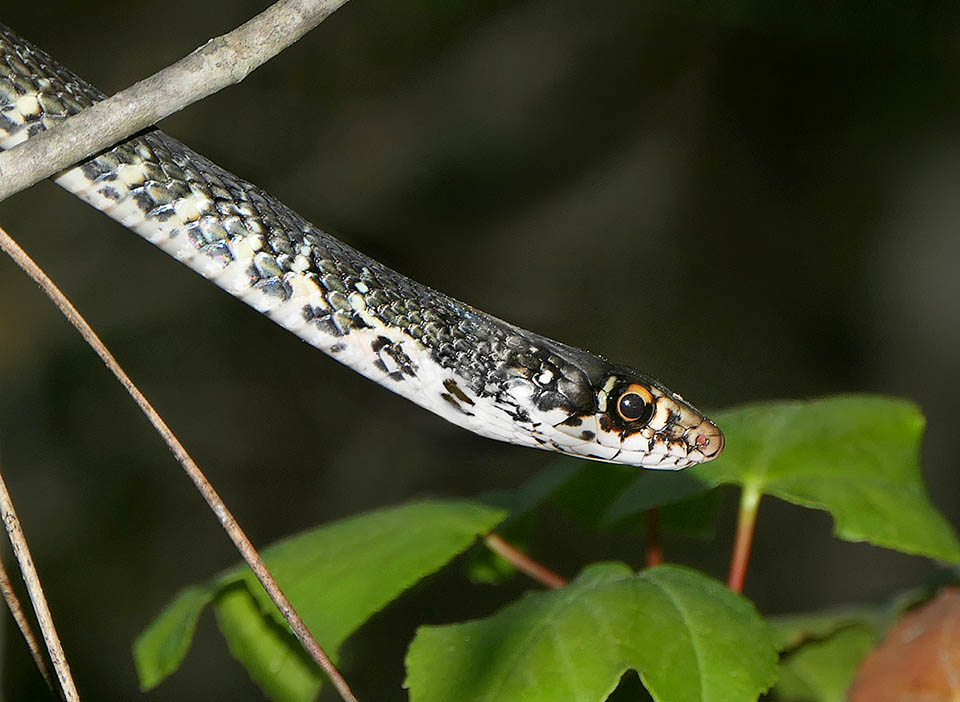Family : Colubridae

Text © Dr. Luca Tringali

English translation by Mario Beltramini

About 1 m long, Hierophis cypriensis is a colubrid endemic to Cyprus classified “EN. Endangered” in the IUCN Red List of the species in danger © Luca Tringali
The Cyprus whip snake, Hierophis cypriensis (Schätti, 1985), is a colubrid (Colubridae, Colubrinae) quite rare and elusive, and is the only snake endemic to the island of Cyprus.
The name of the genus comes from the Greek “ἱερός” (hierós), holy, and “ὄφις” (óphis), snake. In fact, in ancient Greece the snakes were sacred to the gods as, being able to change skin, were considered as symbols of renewal, health and recovery. More immediate is the derivation of the specific epithet, that indicates in Latin the geographical origin of the reptile.
Zoogeography
The origin, the composition and the evolution of the Cypriot herpetofauna have always been of uneasy interpretation, especially due to the complex geological history of the island, that would have originated from two independent islands that, once merged, helped in creating the current appearance of the island.

The dark livery is crossed by clear parallel bands. The snout, paler, bears characteristic white spots close to the eyes and on the head © Luca Tringali
This is presently dominated by two mountain areas: the Troodos (central Cyprus) and the Kyrenia (northern Cyprus), separated by a great plain, the Mesaoria, always from the Greek “μέσος” (mésos), placed in the middle, and “ὄρος” (óros), mountain.
This orographic conformation should partially explain the present distribution range of the Hierophis cypriensis, limited to the areas included between 400 and 1900 m of altitude in the mountain range of the Troodos and absent from the Kyrenia, not reachable by this species because of the wide and arid plain of the Mesaoria.
Furthermore, the data from the molecular analyses, together with the observation of the considerable morphological differences of the Hierophis cypriensis from the congeneric species Hierophis viridiflavus and Hierophis gemonensis support the theory of the isolation of Cyprus from the rest of the European continent for at least the last 5,2 million of years, period during which the speciation should have occurred.

It’s a very elusive snake nourishing of other snakes, lizards, amphibians, rodents and invertebrates © Luca Tringali
Ecology-Habitat
The Cyprus whip snake was recognized as a valid species only in 1985, being often mistaken previously with Dolicophis jugularis, the Black whipsnake, and therefore little is known about its ecological niche.
The established data suggest that this rare endemism is typical to the sub-mountain and mountain areas of central Cyprus, where it lives mainly the woody areas of Pinus brutia and coppice, always close to water streams or basins, even if subject to summer drying.
Its ideal environment is characterized by a cool microclimate, never too dry and not even too wet, always in areas where the light of the sun can enter, albeir minimally, through the thick forest cover.
The absence of watercourses from the range of Kyrenia contributes to explain, together with the ecological barrier formed by the Measoria, the absence of this species from the mountain range of northern Cyprus.
Morphophysiology
Slender snake with very long and thin tail, and with a, established maximum length of 1,165 m.
It can be easily identified by the following characteristics: 17 longitudinal lines of scales along the central part of the body; 124-132 subcaudal scales; small clear spots on the supraocular, parietal and frontal ones; pre- and post-ocular and clear lines through the first half of the body.
Moreover, we note a clear loreal spot, one preocular, two postocular, eight supraocular of which 4°-5° or 5°-6° in contact with the eye, and 6°-7° or 7°-8° bigger.
If the sexual dimorphism in this species is limited to some differences in the pholidosis (number, shape and arrangement of the scales) and in the conformation of the tail as the males have an ampler base due to the presence of the hemipenes, Hierophis cypriensis mdisplays a marked orthogenetic dimorphism: the dorsal livery of the young individuals tends towards beige, whilst ventrally is pink-orange.
After about one year the back changes in green-oliven to modify further in the adults, two and a half years later, in the final black-greenish.
Ethology-Reproductive Biology
It is thought that it is presumably oviparous, but nothing else is known about the reproductive behaviour of this elusive reptile.

Good climber, Hierophis cypriensis lives between 4OO and 1900 m of altitude and is very active during the warmest hours of the day. Deemed oviparous © Luca Tringali
In addition to being, perhaps, the fastest snake of the island, it is also an excellent climber and swimmer.
Though aglyphous, therefore not venomous, it is however very aggressive if handled, and tends to bite repeatedly.
Active mainly between mid-June and late September, Hierophis cypriensis has an opportunistic diet, as this is formed by a vast range of prey: lacertids, other snakes, amphibians, rodents and invertebrates.
Increasingly threatened by the loss of the habitat, especially due to the increase of the paved roads within the forest areas, this snake is classified “EN, Endangered” in the IUCN Red List.
Synonyms
Coluber cypriensis Schätti, 1985; Dolichophis cypriensis Nagy et al. 2004.
→ For general notions about Serpentes please click here.
→ To appreciate the biodiversity within the SNAKES please click here.
